If you think you have a pot-bellied dog, you might wonder, “Could this be something serious? Or is it simply the result of one too many dog cookies?” To help you sort out the difference and know when to call the vet, integrative veterinarian Dr. Julie Buzby gives an overview of the top 10 reasons for a pot-bellied dog.
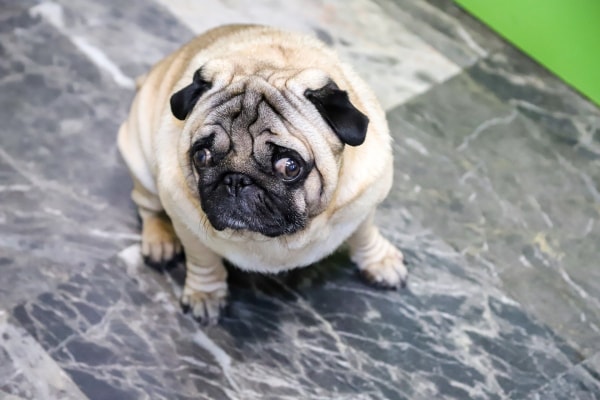
Being a dog parent isn’t always easy. Sometimes we notice changes in our beloved dogs, but don’t know what the changes mean or if they are concerning.
As an example, my long-time client Mr. Douglas brought his dog, Tulip, an 11-year-old female Wire-Haired Dachshund, in for an exam last spring. As Tulip came trotting into the exam room, I immediately noticed her belly was larger than normal.
Mr. Douglas mentioned that he noticed Tulip’s abdomen had been increasing in diameter recently. He told me that he wasn’t sure if it meant anything or if she was just “getting fat.”
Mr. Douglas went on to describe multiple symptoms that he believed were occurring due to Tulip’s senior status. She was beginning to lose hair and had an abnormal coat. Recently, she seemed more tired. And she was urinating in the house now, which she had never done before.
I told Mr. Douglas that he was right to be concerned about Tulip’s new abdominal contour. Rather than just being a bit chubby, she was actually pot-bellied. I went on to explain that there are a wide range of reasons for a dog to be pot-bellied (as we will soon discuss).
However, one cause in particular stood out to me once I heard Tulip’s symptom list. I told Mr. Douglass we needed to run bloodwork to be sure. But I suspected I knew which one of these 10 causes of a pot-bellied dog was the culprit.
What does “pot-bellied dog” mean?
Before we can dive into the 10 reasons a dog might be pot-bellied, I want to make sure we are speaking the same language.
Being pot-bellied means that a dog is suffering from swelling in the abdominal area. The dog’s belly will be round or distended. A pot-bellied dog can appear overweight or bloated.
Additionally, dogs with a pot-belly may have an abnormally shaped abdomen. Their belly may not be symmetrical or tight in normal places. It also might protrude or bulge in abnormal locations. The exact belly shape can vary with the cause.
Sometimes a pot-belly is also referred to as “abdominal enlargement” or “abdominal distention.” The exact term often varies with the cause and user preference.
10 reasons for a pot-bellied dog
Now that we can all agree on what constitutes “pot-bellied,” let’s look at the various causes of an enlarged abdomen.
#1: Being overweight
I want to start with this one first because it can be easy for a dog parent to confuse weight gain with abdominal distension. However, weight gain by itself is usually not considered true abdominal enlargement. While weight gain can give the appearance of a swollen abdomen, it does not cause the abnormal protruding and shape that we see with true pot-bellied dogs.
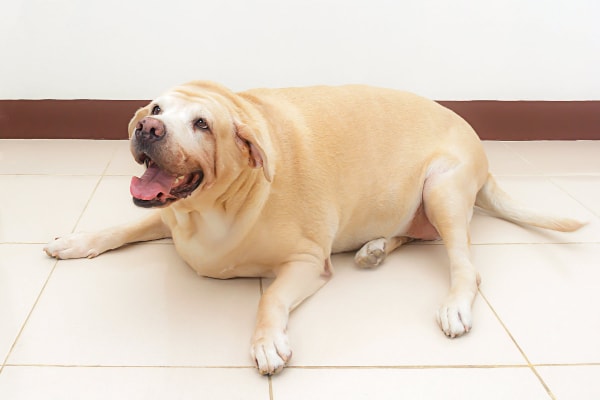
One way to differentiate the two is by looking at the rest of the dog. Dogs who are overweight will often have fat deposits in areas other than just the stomach. So, there might be a bit of extra squishiness around the base of the tail or neck of an overweight dog. On the other hand, with a pot-bellied dog, just the abdomen is distended.
Even if you don’t think your dog has true abdominal enlargement, weight gain is still worth discussing with your vet. Sudden weight gain could be an indication that your dog has an underlying condition like hypothyroidism (i.e. low thyroid hormones). More commonly though, increased weight is due to a problem with diet or exercise.
With weight gain, a dog’s risk for secondary problems can increase as well. For example, dogs who are overweight can be more likely to develop osteoarthritis in dogs or muscle weakness. This can make it increasingly difficult for them to walk and enjoy physical activities.
Wondering if your dog is overweight? Looking for weight management tips for dogs? Have a conversation with your vet and check out these articles to learn more:
- Your Dog’s Body Condition Score (BCS)
- Is My Dog Overweight? Your 7 Most Weighty Questions Answered
- How to Help a Dog Lose Weight
#2: Intestinal parasites
Ever heard of a puppy or stray dog having a “wormy belly?” Parasites that live in your dog’s stomach or intestines can also cause the pot-bellied appearance.
There are many different types of worms or other intestinal parasites that can affect your dog. However, roundworms are the most common one to cause stomach swelling in dogs.
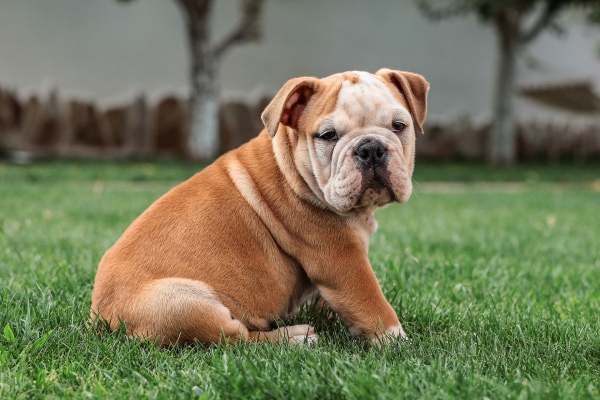
Roundworms
These worms resemble a spaghetti noodle. (My apologies if you were planning to have pasta for dinner tonight.) These worms can vary in length. Some dogs have a huge number of roundworms and others just have a few.
Roundworm eggs (and the eggs or larvae of other parasites) are found in environments that dogs often visit. This means that a wide range of ages, sizes, and types of dogs can become exposed to worms. But while any dog can develop a parasitic infection, there are some dogs that are at an increased risk of having roundworms. These include:
- Puppies—The mother dog can pass worms to the puppies via the placenta or milk. Studies indicate virtually all puppies are born with roundworms and that more than 30% of puppies younger than six months old are shedding roundworm eggs.
- Outdoor dogs—Dogs who spend the majority of their time outside are more likely to contract worms from the environment or wildlife carriers.
After infection, the worms larvae (i.e. baby worms) complete their lifecycle by becoming adults and then beginning to replicate. As the number of worms increase, they can begin to cause a blockage in the dog’s intestines, leading to an upset stomach. This can result in vomiting and diarrhea. Additionally, the worms cause excess gas to build up. This leads to the pot-bellied appearance and discomfort for your dog.
Your vet will diagnose your dog with worms by visually seeing them in the feces and/or by finding their microscopic eggs on a fecal test. Thankfully, the treatment for worms usually consists of giving your dog a deworming medication.
#3: Gastric dilation and volvulus (GDV)
Also known as the “stomach flipping” or “bloat in dogs“, GDV is a cause of abdominal distension that occurs very rapidly. As the name implies, gastric dilation and volvulus occurs when a dog’s stomach rotates into an abnormal position. This twisting on itself is known as a volvulus.
Additionally, gas builds up in the twisted stomach and causes the stomach to dilate. The expansion of the dog’s stomach places pressure on main arteries, restricting blood flow. GDV progresses very quickly and is a life-threatening condition.
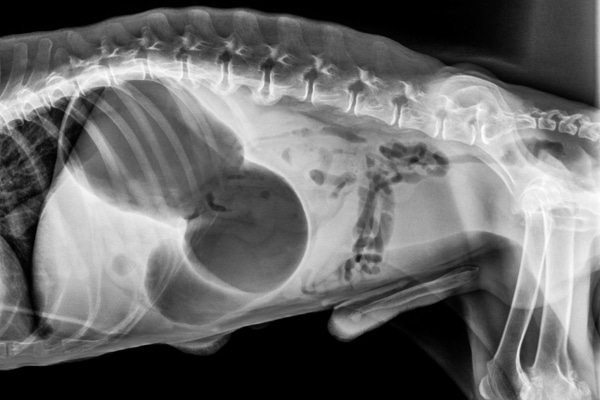
GDV prevention
Deep chested dogs like Great Danes, Doberman Pinschers, Labrador Retrievers, St. Bernards, and Weimaraners are at increased risk for GDV or bloat. So are dogs who eat their meals quickly.
In attempt to prevent GDV, vets often recommend a gastropexy for at-risk breeds. This is a surgery that involves tacking the stomach in place. By performing this surgery, the stomach is less likely to be able to rotate and bloat.
Another preventative measure involves slowing the pace of your dog eating his or her meals. You can accomplish this through many different methods including slow feeder bowls or puzzle bowls.
GDV symptoms
Even if you take every preventative measure possible to prevent GDV, unfortunately some dogs will still develop it. If you suspect that your dog is bloating, some signs you might see include:
- Bloat/ expanding abdominal area
- Difficulty breathing
- Weakness
- Collapse
- Decreased appetite
- Pain when the belly is touched
- Retching (i.e. trying to vomit but nothing comes up)
- Pale or white gums (to learn what normal gums look like, check out my article on dog vital signs.)
If you notice any of these signs in your dog and suspect that he or she is suffering from GDV, please take your dog to the vet immediately. I cannot stress enough that this condition is life-threatening and requires an emergency vet visit.
GDV treatment
Once you arrive at the veterinarian, they will probably want to gather information quickly and then start treating your dog. Treatment may involve IV fluids, passing a stomach tube or inserting a needle into the stomach to relieve gas pressure, medications to support your dog, and then surgery to get the stomach back into normal position.
#4: Internal organ enlargement
Your dog’s belly is full of lots of important organs. So if one of them is larger than normal, this could cause a pot-bellied appearance. As the organ increases in size, there is decreased space in the abdomen. As a result, your dog’s abdomen will expand since it is fuller than normal.
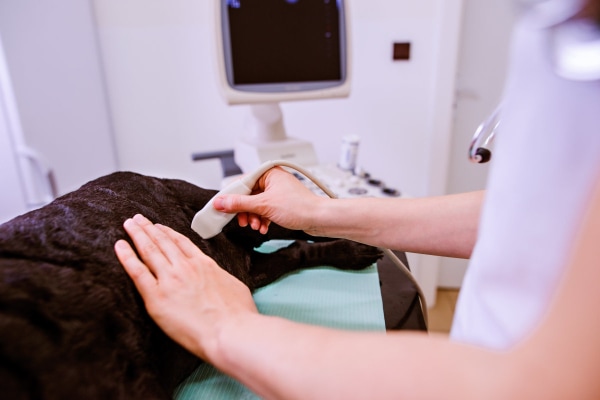
In an addition to an enlarged stomach and intestines like we discussed previously, a dog can also suffer from an enlarged liver, spleen, kidneys, or uterus. These organs can be larger in size for a variety of reasons including:
- Benign enlargement (i.e. the organ is larger but functioning normally)
- Liver disease in dogs
- Kidney failure
- Masses in these organs
- Pyometra (i.e. uterine infection)
The cause and extent of the organ enlargement (i.e. organomegaly) will greatly affect what clinical signs you see. The symptoms can include:
- Distended abdomen
- Diarrhea or constipation
- Vomiting
- Decreased appetite
- Belly painful when touched
- Weakness/ collapse
If you notice these signs, you should consult your veterinarian. He or she will examine your dog and carefully palpate your dog’s abdomen to feel for organ enlargement. If your vet suspects organomegaly after the exam, he or she will probably want to perform diagnostics to get an idea of which organ is enlarged and why it is enlarged. These diagnostics could include bloodwork, X-rays, an ultrasound, or sometimes exploratory surgery.
Treatment and prognosis will depend on the cause of the organ enlargement.
#5: Hemoabdomen
If you break down the word “hemoabdomen” you get “hem” which refers to blood and “abdomen” which refers to the abdomen. So, a hemoabdomen is a blood-filled abdomen.
As mentioned in point #4 above, an organ may be enlarged due to the presence of a mass or masses. Unfortunately, splenic masses in dogs can sometimes remain undetected until they suddenly rupture, filling the abdomen with blood. One cancer that is commonly responsible for causing a hemoabdomen is hemangiosarcoma in dogs. This is a cancer that usually develops in the spleen but can also affect other organs like the liver.
A hemoabdomen can also occur for other reasons such as:
- Surgical complication
- Trauma, such as a penetrating wound or a car accident
- Underlying bleeding condition due to an auto-immune disorder or exposure to anti-coagulant rat poison
Signs of a hemoabdomen include:
- A distended abdomen
- A lethargic dog
- Sudden collapse
- Pale mucous membranes
- Vomiting blood
- Blood in feces
- Difficulty breathing
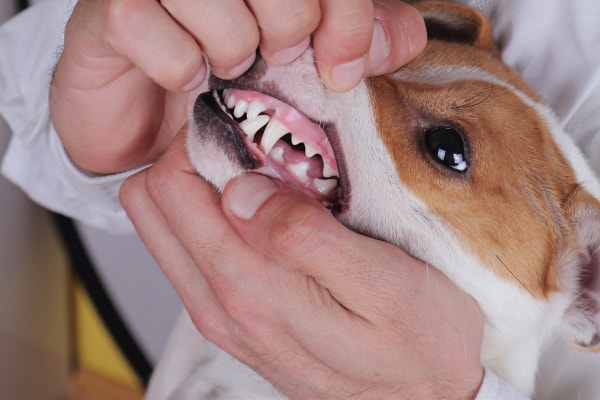
If you suspect a blood-filled abdomen, please take your dog to the veterinarian immediately. This can often be a life-threatening condition.
Depending on what your veterinarian suspects is the cause, diagnostics include blood tests, ultrasounds, and X-rays. Your dog may require emergency surgery to remove the bleeding mass or repair the trauma or surgical complication.
Also, your vet might recommend fluids or a blood transfusion to address the blood loss. Sometimes, he or she might also try an herb called Yunnan Baiyao for dogs that can help stop the bleeding. If your dog ingested anti-coagulant rodenticide, your vet may also administer Vitamin K or other medications.
#6: Uroabdomen
Another fluid that could fill your dog’s abdomen and cause a pot-bellied appearance is urine. This is called a uroabdomen.
A more common cause of uroabdomen is a ruptured bladder, which can occur due to:
- Trauma (such as a dog fight or car accident)
- Blockage (due to stones or a mass)
- Bladder wall tearing due to a weak integrity (such as when a mass is present)
While less immediately life-threatening than a hemoabdomen, it is still important to seek immediate veterinary care if you suspect your dog has a uroabdomen.
The veterinarian will likely perform blood tests, an ultrasound, and/or an X-ray to determine the cause and make a treatment plan. If the uroabdomen is a result of a ruptured bladder, your dog will typically also need surgery to repair the bladder.
For more details about uroabdomen, check out the article entitled A clinical review of pathophysiology, diagnosis, and treatment of uroabdomen in the dog and cat in the Journal of Veterinary Emergency and Critical Care.
#7 Heart failure
You might be saying to yourself “Wait a minute! The heart isn’t in the abdomen!” But bear with me because it will make sense soon. When a dog suffers from heart failure, the heart is not able to pump blood properly through the body.
This results in blood backing up in the vessels sort of like a traffic jam. And, to continue the analogy, fluid is forced out of the vessels and into the surrounding tissue just like people may get off the highway and take a detour through the surrounding area. When the fluid takes a “detour” into the abdomen, it can cause ascites (i.e. fluid buildup in the abdomen).
The ascites can cause a pot-bellied appearance. If you tap a dog’s fluid-filled abdomen, you might see a wave-like appearance across it or feel some sloshing. This is called a fluid wave.
You may also notice other symptoms of heart disease in dogs such as:
- Dog who is breathing fast
- Reduced exercise tolerance
- Coughing
- Collapse
If you see any of these signs, make an appointment with your vet promptly. Heart failure requires close monitoring by a veterinarian. This process often involves periodically repeating X-rays, ultrasounds of the heart (called echocardiograms), and blood pressure checks.
Additionally, there are multiple medications that can play an important role in caring for a dog with heart failure. These medications help improve heart function, regulate blood pressure, and remove extra fluid buildup.
#8: Pregnancy
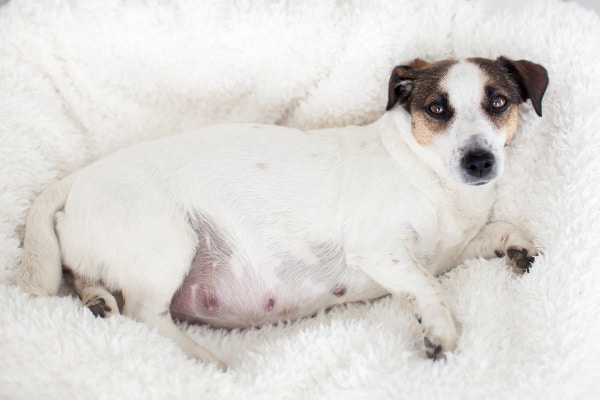
In female dogs, pregnancy can be another cause of a growing abdomen. Pregnancy does not usually give the specific “pot-bellied appearance” that we have been discussing. But, it does cause the abdomen to be larger and have an abnormal contour.
One of the biggest ways to distinguish a pregnant dog from one of the other causes discussed, is mammary gland enlargement. Dogs are pregnant for a much shorter time period than humans—only about 58 to 68 days. Around day 45 is when the mammary glands begin to increase in size and prominence. Some dogs will also start lactating (i.e. producing milk) about a week before the delivery of the puppies.
If you suspect your dog is pregnant, you should schedule an appointment with your veterinarian. He or she can check your dog for pregnancy using a blood test, ultrasound, or X-ray. Around days 45 to 50, your vet can use the X-ray to count puppies as well.
#9: Hypothyroidism
Low thyroid levels can cause dogs to gain weight even if they have not been eating more food. This weight gain can cause the abdomen to appear swollen or like a pot-belly.
Hypothyroidism in dogs also causes several other symptoms to monitor for:
- Hair thinning or worsening coat health
- Flaky skin
- Skin infections
- Decreased energy
- Cold intolerance
Vets diagnose hypothyroidism using blood tests that measure thyroid hormones. Sometimes, it can take a couple of tests to confirm or rule out low thyroid hormones.
If your dog is diagnosed with hypothyroidism, your vet will likely start him or her on a medication to increase the thyroid hormone levels to a normal range. In this case, your dog will also need regular monitoring. This is necessary in order to ensure that he or she is receiving the correct dose to keep the levels in the appropriate zone.
#10: Cushing’s disease
Also known as hyperadrenocorticism, Cushing’s disease in dogs occurs when the adrenal glands produce too much of a hormone called cortisol. Cortisol is important for regulating many functions in your dog’s body. However, too much of a good thing is a bad thing when it comes to cortisol.
Cushing’s syndrome occurs most often due to a tumor in the pituitary gland (i.e. the portion of the brain that tells the adrenal glands to make cortisol). It also can be a result of a tumor in the adrenal gland that produces too much cortisol. Additionally, extended use of steroids can cause a form of Cushing’s disease called iatrogenic Cushing’s disease.
Cushing’s can cause a wide variety of clinical signs. These include:
- Pot-bellied appearance
- Increased hunger
- Hair loss
- Heat intolerance
- Decreased energy
- Increased thirst in dogs
- Increased urination
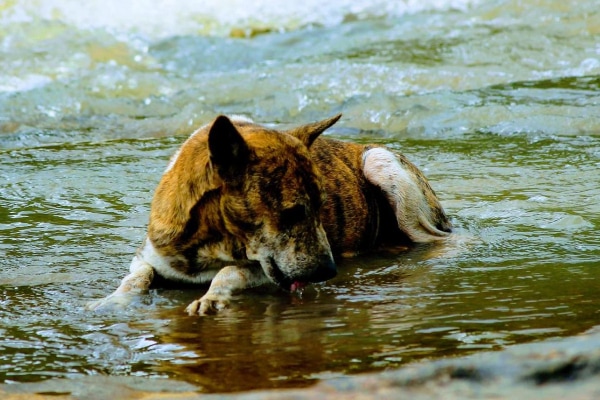
Some of these symptoms sound a lot like what my client was seeing in Tulip, don’t they? I recommended performing diagnostics to confirm that she had Cushing’s.
Reaching a Cushing’s disease diagnosis
When diagnosing Cushing’s, there are different blood tests that your veterinarian might be use. First, he or she might run basic blood and urine tests to rule out other possible diseases. If things are still pointing to Cushing’s, the vet will potentially proceed to the tests specific to Cushing’s. These include:
- Urine cortisol creatinine
- ACTH stimulation test
- Dexamethasone suppression test
Diagnosing Cushing’s is not always straight forward. Sometimes, tests can come back borderline and difficult to interpret. This is where an ultrasound of the abdomen, with a focus on the adrenal glands, also might be helpful. During the process, remember to be patient with your veterinarian. They are working hard to help confirm a diagnosis for your dog.
After obtaining a diagnosis, your veterinarian will discuss treatment with you. Depending on your dog’s specific situation, this could involve medication or surgery. Regardless, once your dog is diagnosed with Cushing’s disease, he or she will need routine monitoring to ensure the cortisol levels are properly controlled.
Answers for Tulip
As I suspected, the diagnostic tests indicated that Tulip did have Cushing’s disease. I started her on Trilostane for dogs and am happy to report that for the last year, she has been living life to the fullest with her dad! Her hair coat is better, she is no longer having urinary accidents, and she has so much more energy!
Work with your veterinarian
As you can see, there are many conditions that could lead to your dog developing a pot-belly. So if you have any concerns about your dog’s abdominal shape, please consult your veterinarian. Sometimes, like Tulip’s dad did, you can schedule a non-urgent appointment with your vet.
However, there are conditions on this list like GDV, hemoabdomen, uroabdomen, and severe heart failure where time is of the essence. In those situations, please seek emergency care immediately.
Regardless of the cause, work closely with the veterinarian during the process. He or she is a great ally and a wonderful resource to help you care for your dog.
If your dog had a pot-bellied appearance, what ended up being the cause?
Please comment below.


i just adopted a ten week old pup and on the ride home noticed that i could kinda see the intestine in her tummy at a particular angle. i’m not fully sure if i should worry or not but the rest of hee is pretty thin. is it just the chubby puppy belly full of food or something worse.
Hi Ck,
Congrats on your new puppy! I understand your concern and wish I had answers, but it is hard to offer specific conclusions without being able to examine your pup myself. Your best bet is to schedule a first visit with your vet. They will look over your dog’s whole body and let you know if anything seems abnormal. Hopefully you can get some peace of mind and start things off on the right track. Wishing you and your sweet girl many happy years together!
We have a 16 week old puppy and she has had a pot belly since we got her. We have done two rounds of deworming and fecal tests show negative. She behaves healthy but I feel she drinks a lot of water and she is always hungry. I had to start feeding her in a slow feeder bowl because she would gobble up her food so quickly.
She is gaining weight and plays with our other dogs and seems to be pain free however her belly looks so large.
Can puppies get cushings? We are in the early stages of testing her to see what is causing the large belly but I was wondering what the other causes for this might be.
Hi Jenny,
I understand your concern for your puppy and agree this is quite a puzzling situation. I am glad your vet is planning to do some in-depth testing. I hope you will get the definitive answers you need to ensure your girl remains happy and healthy. At such a young age, I am always suspicious about something genetic or congenital. How are things today? Feel free to keep us updated as new information comes to light. Wishing you and your sweet girl all the best.
hi my dog was started on high dose of corticosteroids. can he get potbelly in a week?
Hi Barbara,
I have not personally seen a potbelly develop that quickly, but I guess anything is possible. If you have concerns about steroid side effects, don’t hesitate to reach out to your vet. Wishing you and your pup all the best.
My 11 year old rescue Maltese woke up this morning with a distended tummy. She acts normal in every other way. Should I be concerned? I let her outside and she potties and peed, came back in and jumped up on my bed and went back to sleep.
Hi Lydia,
I understand your concern for your senior girl with this sudden change in her appearance. Unfortunately, without examining her myself I can’t make specific conclusions about her health and well-being. I like to err on the side of caution and think it would be wise to go ahead and call your vet. They can let you know if an exam is recommended or if you should continue to monitor things at home. Hoping all is well and wishing you both the best!
My girl was diagnosed with Cushings Disease in Feb of 2023. She has been on Vetoryl now for 9 months and all of her symptoms have subsided except for her huge pot belly. The vet took xrays in the beginning and said it was not ascites but that her liver was enlarged. Is there anything that can be done, or that I should be doing to help her lose her potbelly. I called the vet to see if she might also be dealing with hypothyroidism, but he hasn’t called me back. Would appreciate any input you might have.
Hi Dori,
I am glad your pup has responded so well to the Vetoryl and her symptoms have improved. Unfortunately, most dogs with Cushing’s will keep the potbellied appearance even if the disease is well controlled. It just seems to be an irreversible change for most Cushing’s patients. As long as her thyroid level is normal and there are no other lingering issues, I’d call it a win and try not to worry about it. Your girl is lucky to have you advocating for her health and well-being. Wishing you all the best and keep up the good work!
I know it’s been a few months. My last dog Bailey had Cushing’s and it took her belly time to go away but it was on of the last things that did. I want to say it took hers about 1 year to start getting smaller, but at year 2 she was much better. During that period we went through a dose change once, where we increased her dose. It takes a lot of patience and love ❤️
Hi Alexis,
Thank you for sharing your experience. I appreciate you taking the time to offer advice and support to others!
My 8 year old basset hound died suddenly of cardiac arrest in the ER recently. She presented with a huge spleen. When we rescued her at 2 years old, she tested positive for Lyme disease and we were told she had an enlarged spleen. Our vet treated her with antibiotics even though she didn’t have any other symptoms. Seven years passed with no health issues. We recently started noticing a pot belly appearance but attributed it to her age. The vet didn’t express any concern. She stopped jumping on the couch and preferred that we lift her up. Everything else was normal until one morning. Tinker threw up before breakfast and as I was cleaning that up, she emptied her bowels in the house (highly unusual for her to have accidents in the house). As I was cleaning that up, she jumped into her favorite chair and laid down. She refused to eat her breakfast, again highly unusual. Tinker seemed OK, maybe just a belly ache until she went outside and laid down on her side. I could tell something was seriously wrong at this point, so we rushed her to the vet ER. She went into cardiac arrest in my arms. The vet did CPR but Tinker did not recover. The only thing the vet could tell us is that her spleen was “huge”. I don’t know if her early bout with Lyme disease contributed to her death. She was a stray so I have no idea if or when the Lyme disease was treated other than us treating her when we adopted her. Tinker was a great dog though, and we loved her dearly. We miss her everyday.
Dear MaryGrace,
I am sorry for your tragic loss of Tinker. I can only imagine how much you miss her. She was a lucky girl to have shared her life with such a loving family. It sounds like you did everything you could to save her, and I am certain your presence was a comfort during her final moments. May her memory stay with you always and continue to be a blessing in your life. Wishing you all the best as you continue life’s journey.
My 10yrs old dog has pot belly ,more dinking and urinating than usual.But When I tested her with basic blood test,ALKP Level is normal rate and ALT Level result <10. Can my dog have cushing's disease when AKLP range normal?
Please help,sir!I can't lose her.
Hi Jacqueline,
I understand your concerns about the changes you are seeing in your dog. Without examining your pup, myself, it is hard to make specific conclusions or recommendations. Please talk to your vet and make sure they are aware of these ongoing issues. They may want to do some different testing or see how your dog responds to treatment. I am hopeful you will find the answers you need to ensure your sweet girl is happy and healthy. Wishing you both the best.
Hello,my 7 Yr old female black lab has swollen abdomen which she reacts to on touch.No other symptoms.Just finished period.
Hi Diane,
A painful distended abdomen is always an emergency as far as I am concerned! I highly recommend you have your girl examined as quickly as possible. Hoping your pup is ok!
Hi, My 10 year old schnoodle female was just diagnosed with diabetes. We almost lost her but she is stable now. She has a little pot belly and the vet thinks she could also have cushings. However, she is a puppy mill dog and has a very compact anatomy. She has always had a pot belly looking back at pictures from 5 -6 years ago. Is it possible that she just has a little pot belly? I don’t want to lose her and am worried about keeping her healthy. We plan to the Dex test shortly.
Thank you
Annette
Hi Annette,
I am sorry your senior girl has been diagnosed with diabetes. I understand your concern and not wanting there to be additional issues contributing to her problems. Cushing’s is a real possibility but then again, I guess anything is possible. Did you get the results of the dex test? How is your girl doing today? Hoping you found the answers needed to move forward with treatment. Feel free to leave an update if you get a chance.
Still trying to figure out the cause in our 5 year old neutered male ridgeback.
He’s recently been diagnosed with Addison’s so he’s on steroids.
We just started Thyrosin in case he’s hypothyroid (like my previous two ridgebacks). It’s my understanding that the results of testing his thyroid levels won’t be accurate because he is on steroids for the Addison’s.
Hi Anne,
You are correct that Addison’s and steroids can cause some false changes on thyroid levels when tested. I hope you were able to find some answers and get your sweet boy back on track. How are things today? Wishing you both the best of luck.
My dog has a swollen belly. I took him to the vet and they said he had heartworms. The vet used a syringe and drawed liquids from his belly. The doctor said there was nothing else to do and that he was suffering to breathe. He said the only solution was to sleep him. Do you think there’s any solution to it? He said he could give him some antibiotics to help him breathe better but wouldn’t heal completely. Said the chance of healing is 2%. What do you say?
Hi Camila,
I am sorry your pup is in such poor health. Without examining him myself, I can’t make specific conclusions or recommendations. If your dog truly has heartworm disease that is so advanced it is causing fluid to accumulate in the abdomen, then yes, I do think his prognosis is very grave. Saying goodbye may be the most loving option and only way to give your sweet boy freedom from his suffering. Hoping you can make the best decision for you and your boy. Bless you both.
my JoJo was taken to the emergency vets for a swollen belly. they drained 2.5 litters out of his stomach including a heart worm. they told me his prognosis was not good and recommended he be euthanized. I told them no, I would take him to my vets. we got a pizza, cried and shared it on the love seat. my vets put him on antibiotics for 30 days and i believe steroids. I bought every treat money could buy, put him on science diet, and Vitamins twice a day. when I took him back after 30 days, my vet was amazed. he got his first injection, then came home. then about 6 or 8 weeks later he went in and stayed overnight for two injections. he will he on lasik the rest of his life. he is happy, healthy, and sits and waits for all those treats and vitamins. don’t euthanize your dog. give them a chance, he was always happy, and never stopped wagging his tail.
Hi Teresa,
I am so glad this turned out favorably for your pup! Jojo is very lucky to still be alive and I am amazed at his remarkable recovery. I too would probably have recommended euthanasia at the time. There are just some things that defy logic, and we can’t foresee all the possible outcomes. Thank you for sharing your story with us. Wishing you and Jojo many happy days ahead!
Hi Ms Julie, I’m quite concerned about the health of my pupps. I have 2 pitbull puppies that are a month old. They both got pot bellies and I took them to a local vet were they dewormed them and hours later they started releasing stool with roundworms. 2 days later since I took them to the vet their bellies are even bigger and whenever they are asleep they twitch a lot and one of them breathes fast and or in an abnormal manner.
Your assistants would be highly appreciated
Hi Mpendulo,
I understand your concern for your puppies. What you describe sounds like what would be expected for puppies with intestinal parasites. It can often take more than one deworming to ensure all the roundworms are gone as they can also pick them up again from the soil outside. This is why staring them on a monthly parasite prevention regimen is so important. Please be careful when cleaning up feces and practice good handwashing as roundworms are potentially contagious to humans. Twitching and breathing fast during sleep can be a normal dreaming behavior for dogs. If you think something else may be causing a problem, don’t hesitate to reach out to your vet for advice. Hoping all is well and wishing you all the best with your two new pups!